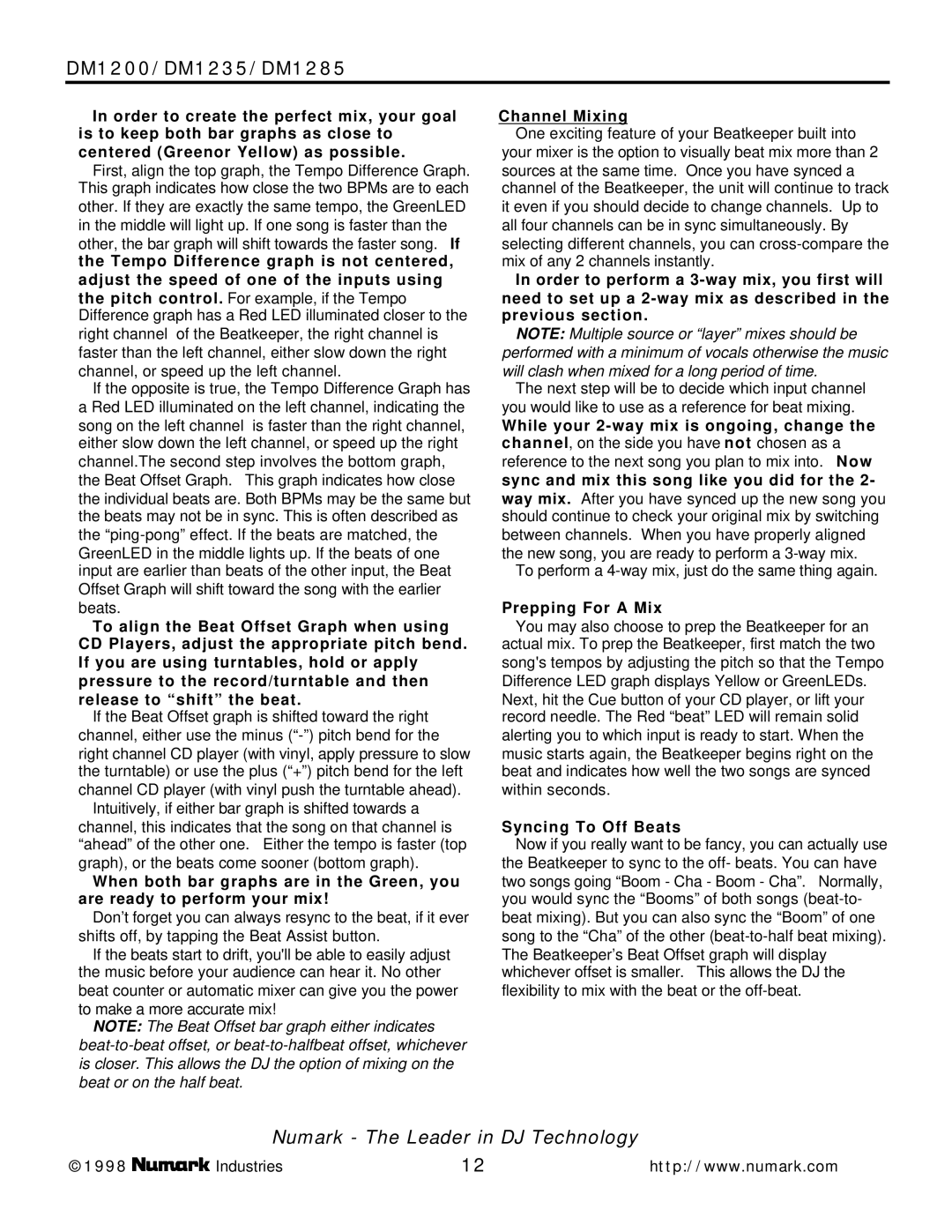
DM1200/DM1235/DM1285
In order to create the perfect mix, your goal is to keep both bar graphs as close to centered (Greenor Yellow) as possible.
First, align the top graph, the Tempo Difference Graph. This graph indicates how close the two BPMs are to each other. If they are exactly the same tempo, the GreenLED in the middle will light up. If one song is faster than the other, the bar graph will shift towards the faster song. If the Tempo Difference graph is not centered, adjust the speed of one of the inputs using the pitch control. For example, if the Tempo Difference graph has a Red LED illuminated closer to the right channel of the Beatkeeper, the right channel is faster than the left channel, either slow down the right channel, or speed up the left channel.
If the opposite is true, the Tempo Difference Graph has a Red LED illuminated on the left channel, indicating the song on the left channel is faster than the right channel, either slow down the left channel, or speed up the right channel.The second step involves the bottom graph, the Beat Offset Graph. This graph indicates how close the individual beats are. Both BPMs may be the same but the beats may not be in sync. This is often described as the
To align the Beat Offset Graph when using CD Players, adjust the appropriate pitch bend. If you are using turntables, hold or apply pressure to the record/turntable and then release to “shift” the beat.
If the Beat Offset graph is shifted toward the right channel, either use the minus
Intuitively, if either bar graph is shifted towards a channel, this indicates that the song on that channel is “ahead” of the other one. Either the tempo is faster (top graph), or the beats come sooner (bottom graph).
When both bar graphs are in the Green, you are ready to perform your mix!
Don’t forget you can always resync to the beat, if it ever shifts off, by tapping the Beat Assist button.
If the beats start to drift, you'll be able to easily adjust the music before your audience can hear it. No other beat counter or automatic mixer can give you the power to make a more accurate mix!
NOTE: The Beat Offset bar graph either indicates
Channel Mixing
One exciting feature of your Beatkeeper built into your mixer is the option to visually beat mix more than 2 sources at the same time. Once you have synced a channel of the Beatkeeper, the unit will continue to track it even if you should decide to change channels. Up to all four channels can be in sync simultaneously. By selecting different channels, you can
In order to perform a
NOTE: Multiple source or “layer” mixes should be performed with a minimum of vocals otherwise the music will clash when mixed for a long period of time.
The next step will be to decide which input channel you would like to use as a reference for beat mixing.
While your
To perform a
Prepping For A Mix
You may also choose to prep the Beatkeeper for an actual mix. To prep the Beatkeeper, first match the two song's tempos by adjusting the pitch so that the Tempo Difference LED graph displays Yellow or GreenLEDs. Next, hit the Cue button of your CD player, or lift your record needle. The Red “beat” LED will remain solid alerting you to which input is ready to start. When the music starts again, the Beatkeeper begins right on the beat and indicates how well the two songs are synced within seconds.
Syncing To Off Beats
Now if you really want to be fancy, you can actually use the Beatkeeper to sync to the off- beats. You can have two songs going “Boom - Cha - Boom - Cha”. Normally, you would sync the “Booms” of both songs
Numark - The Leader in DJ Technology
©1998 | Industries | 12 | http://www.numark.com |
